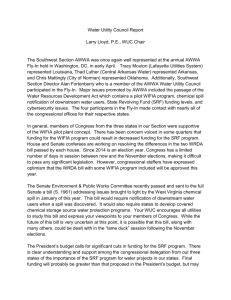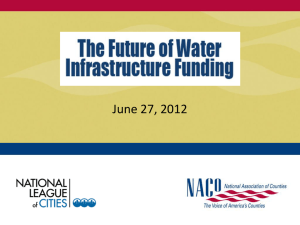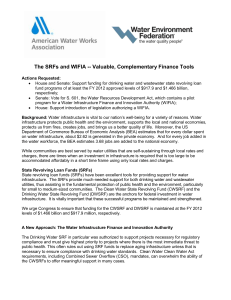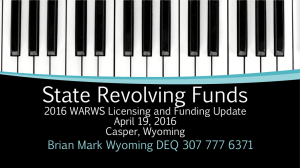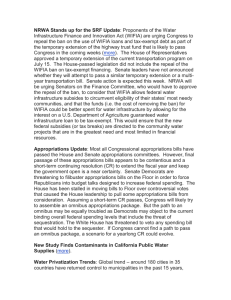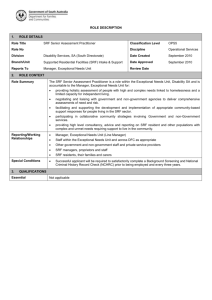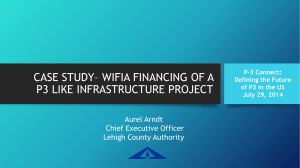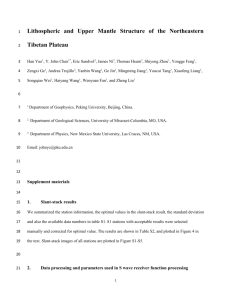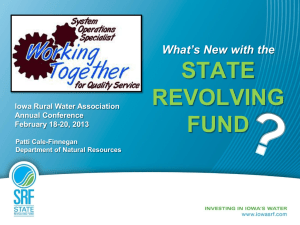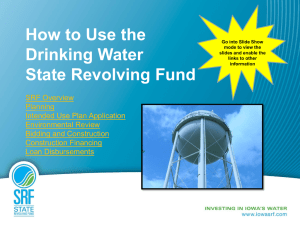Legislative Options for Financing Water Infrastructure
advertisement
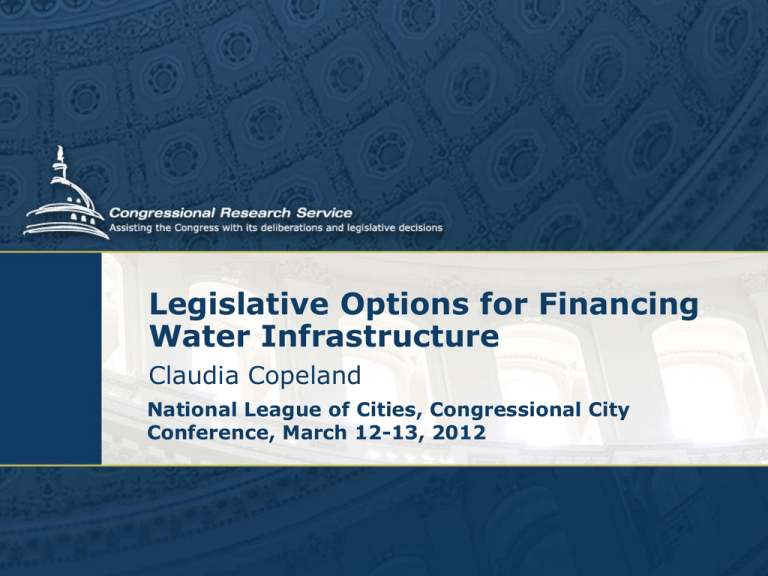
Legislative Options for Financing Water Infrastructure Claudia Copeland National League of Cities, Congressional City Conference, March 12-13, 2012 Water Infrastructure Indicator No. 1: $633 Billion (EPA-estimated 20-year capital needs for wastewater and drinking water) CRS-2 Water Infrastructure Indicator No. 2: $224 Billion (EPA-estimated 20-year water infrastructure financing gap between capital needs and available funds from all sources) CRS-3 5 Legislative Options under Consideration to Close the Financing Gap • Increase funding for the Clean Water and Drinking Water SRF programs • Create a Water Infrastructure Trust Fund • Create a Water Infrastructure Finance and Innovation Act program (“WIFIA”) • Create a National Infrastructure Bank • Lift private activity bond restrictions on water infrastructure projects CRS-4 Conclusion • There is no silver bullet, no single option that will address needs fully or close the financing gap • A combination of options may be helpful to expand the financing tool box • Congress has recently shown increased interest in water infrastructure financing issues, but legislative prospects are highly uncertain CRS-5 1. Increase Funding for the Clean Water and Drinking Water SRF Programs • State Revolving Funds (SRF) are the largest source of federal financial assistance for water infrastructure • SRFs are low-interest (or zero-interest, or belowzero) loan programs administered by states; loans are repaid to states • SRFs are capitalized by federal appropriations, states provide at least 20% matching funds • Both programs are well established and successful in addressing water quality problems • SRFs are flexible, and selection criteria and procedures are familiar to stakeholders CRS-6 Increase SRF Funding, cont. • Issues and criticisms: • SRF is a loan program, but some communities want grants • SRFs favor small and medium communities • Clean Water SRF bars private utilities from receiving assistance • Federal capitalization grants are subject to congressional appropriations, which generally have been flat or declining for more than a decade • President’s budget requests 15% less for next year • Securing future SRF appropriations will be more difficult CRS-7 Increase SRF Funding, cont. • Current legislation: • H.R. 3145 (Rep. Bishop) would reauthorize the clean water SRF for 5 years, total $13.8 billion • Same as H.R. 1262, passed by House in 111th Congress • No current House or Senate proposal to reauthorize the drinking water SRF CRS-8 2. Create a Water Infrastructure Trust Fund • Objective is to provide dedicated revenues for long-term financing of water infrastructure projects • Trust fund would be modeled after existing mechanisms for infrastructure (e.g., airport and airways trust fund, highway trust fund) • Intention is to offset budgetary expenditures for water projects by drawing from collections that are dedicated by law for specified purposes CRS-9 Water Infrastructure Trust Fund, cont. • Design issues to be addressed (2009 GAO report): • What entity should administer a trust fund • Should trust fund be used to fund the SRFs or a separate program • What types of financial assistance (loans or grants) • What activities are eligible for assistance CRS-10 Water Infrastructure Trust Fund, cont. • Most difficult issue, conceptually and politically, is how to generate revenues • Options: excise taxes on beverages, pharmaceuticals, consumer products; fees on toxic pollutant discharges; water use tax; excise tax on pesticides & fertilizers; corporate profits tax • Expenditures are subject to appropriations • Legislation • H.R. 3202 in 111th Congress (Blumenauer), intended to generate $10 billion/year for trust fund • H.R. 3145 in 112th Congress (Bishop), focuses on clean water and defers identifying revenue sources, pending CBO study CRS-11 3. Create a WIFIA (sometimes called a Water Infrastucture Bank) • Objective is to create a mechanism to provide low-cost capital for water infrastructure investments • Modeled after successful Transportation Infrastructure Finance and Innovation Act (TIFIA) • WIFIA would access U.S. Treasury funds at low interest rates • Would provide loans, loan guarantees, other credit support for large projects and those with national or regional importance • Also could lend directly to SRF programs that leverage their capitalization grants to increase loan activity (27 states leverage) CRS-12 Create a WIFIA, cont. • Funds would be repaid to the Treasury, and default rate is expected to be low, so there is little cost to the federal government (subsidy cost only) • Issues: • Governance structure (e.g., EPA or Board of Directors) • Project prioritization and selection criteria (i.e., what about small projects?) • Relationship to SRFs • Would WIFIA shift decisionmaking from states and localities to federal level? • Will WIFIA bring increased investment, or will it substitute for SRF leveraging or municipal debt? CRS-13 Create a WIFIA, cont. • Legislation: • H.R. 3145 (Bishop) • Draft bill discussed at February 28 hearing of the House Water Resources and Environment Subcommittee (Gibbs) CRS-14 4. Create a National Infrastructure Bank • Similar to WIFIA, except NIB would assist multiple types of infrastructure • Proponents say-• Bank could increase total infrastructure investment by leveraging state, local, and private resources • Bank could accelerate projects now slowed by waiting for annual allocation of funds • Bank could promote distribution of federal spending on the basis of anticipated returns to investment, rather than traditional allocation methods CRS-15 National Infrastructure Bank, cont. • Issues: • Project selection--proposals focus on projects of regional or national significance that will contribute to economic growth and job creation, and most specify a minimum project cost (i.e., $100 million) • Will water infrastructure projects be squeezed out? • Will a bank meet needs in small and medium communities? • Will a bank increase investment, or duplicate or substitute for existing programs? CRS-16 National Infrastructure Bank, cont. • Administration supports • Multiple legislative proposals: • S. 652 (Kerry, Hutchison) • Similar to S. 1549 (Reid) and S. 1769 (Klobuchar) • H.R. 402 (DeLauro) • S. 1550 (Brown of OH)/H.R. 3259 (Fudge) • S. 936 (Rockefeller), transportation only CRS-17 5. Lift the state volume cap on PABs for water infrastructure projects • The federal government helps finance water infrastructure by exempting interest earned on municipal bonds from federal income tax, thus lowering borrowing costs for municipalities • But the federal government restricts the use of taxexempt municipal bonds, limiting the extent to which private companies can benefit from the federal subsidy • In cases where a private company’s involvement exceeds allowed thresholds for issuing municipal bonds, the municipality may be able to issue another type of taxexempt bond called a qualified private activity bond (PAB) • PABs for water infrastructure projects are subject to a state volume cap. Under the cap, wastewater and drinking water projects compete against other sectors (e.g., education, housing) CRS-18 Lift the PAB cap, cont. • Interest is growing in exempting PABs used for drinking water and wastewater infrastructure from the unified state volume cap • Current law provides such an exemption for government-owned and operated solid waste disposal facilities • Opponents argue for maintaining restrictions on taxexempt financing, because of the costs to the government, in terms of income tax revenues foregone. Some opponents say that the bonds represent an inefficient allocation of capital, favoring some projects over others, and increasing the cost of financing traditional governmental activities CRS-19 Lift the PAB cap, cont. • Legislation: • H.R. 1802 (Pascrell)/S. 939 (Menendez) • Senate Finance Committee’s revenue portion of the current highway bill includes a provision to lift the state volume cap for 6 years (for bonds issued before Jan. 1, 2018) • This provision is estimated to reduce revenues to the Treasury by $95 million over 6 years, and $305 million over 11 years CRS-20 Conclusion • Consensus exists many among stakeholders on the need for more investment in water infrastructure, BUT THERE IS NO SILVER BULLET • Many support one or more options for doing so—a combination to expand the financing tool box • Congress has recently shown greater interest through House and Senate hearings • But the way forward legislatively is highly uncertain CRS-21 Questions? CRS-22 Claudia Copeland Specialist in Resources and Environmental Policy Congressional Research Service ccopeland@crs.loc.gov CRS-23
